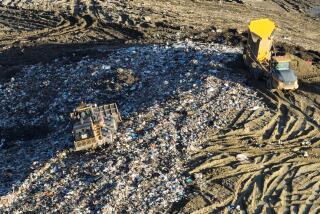Regulators See Germany’s Recycling Program as a Green Giant
- Share via
COLOGNE, Germany — Barely a decade old and already a world leader in recycling, this nation’s Green Dot program is presenting European neighbors with the uncomfortable question of whether principle is more important than performance.
The nonprofit Duales System Deutschland exceeds every environmental goal set under a sweeping 1991 law on packaging disposal, but it does so because it enjoys a near monopoly in what has grown into a $40-billion annual business in Germany.
And that, say the competition watchdogs of the European Commission, is an unfair advantage that must be dumped in the interest of free markets.
Since an EC ruling last year that Green Dot stifles competition, the program has been under pressure from the office of European Competition Commissioner Mario Monti to cease presenting itself to fee-paying producers of packaging as an all-or-nothing way to get rid of the trash they create. Green Dot may do the best job on the Continent of turning waste into worth, but it must let others take on some of the lucrative load, Monti’s office and the European Court of Justice decided.
At Green Dot headquarters in this Rhine River city, director Wolfram Brueck argues instead for a policy that boils down to the adage: If it ain’t broke, don’t fix it.
In fact, said Brueck, Green Dot’s performance depends on the huge volume of waste ensured by its control of the market.
The program’s right to process every can, bottle, bag or container placed in its receptacles, which are located in virtually every home in Germany, ensures that there is money for investment in research and development of better waste disposal and recycling techniques, he said.
“We have done our part to build up a recycling industry that performs better here than anywhere else in the European Union,” Brueck said, pointing out the company’s breakthrough technology that makes glass recycling profitable and produces everything from fuel to lawn furniture using reprocessed plastic.
Germany recycles about 30% of its household waste, a bigger proportion than any other developed country, according to the Organization for Economic Cooperation and Development.
The other 70% still goes to landfills, but that share will have to be drastically reduced within three years when a law takes effect prohibiting disposal of unprocessed waste at such sites, said Green Dot communications director Heike Schiffler. She and Brueck argue that farming out part of the recycling work to for-profit competitors will shave off earnings in Green Dot’s lucrative sectors that fund research needed to meet those impending tougher targets. Two of the best earners--glass and aluminum--are likely to suffer anyway next year when a new law imposing higher deposits on drink cans and bottles will encourage consumers to return them to stores instead of putting them in Green Dot containers.
The restrictions on landfill dumping beginning in 2005 will mean that more waste will have to be incinerated--a process that could imperil air quality unless further refinement of the burning technology can be achieved, Brueck said.
Green Dot defenders say potential competitors want only those aspects of the job that provide quick profits, such as aluminum and glass recycling. Plastics are much more expensive to recycle and the market for resale is still limited, making that sector less attractive for businesses just getting a foothold.
Critics, however, say opening the market would reduce costs and make the system more efficient.
“The way the system is designed at present makes it almost impossible for any competitor to get involved. You are basically required to replicate the existing network, even though it is far from efficient,” said Wolfgang Schertz, director of the Landbell disposal firm in Mainz, which wants in on the recycling action. “If we were allowed to create a more rational system, we could collect and dispose of household waste for far less money.”
Green Dot charges its 19,000 producer-clients for the right to print the Green Dot logo on their packaging and uses those licensing fees to fund a nationwide network of collection, sorting, processing, sales and disposal. Only products with the logo are meant to go into the program’s bins.
Would-be competitors such as Landbell contend that the Green Dot attempt to recycle more plastics rather than incinerate smaller items is too expensive, accounting for the $2-billion-a-year costs that Green Dot charges producers--which are passed on to consumers through higher prices.
In 2001, Green Dot managed to exceed its government-imposed recycling quotas, returning for reuse 93% of glass, 87% of plastic and 65% of waxed container packaging. Because it also recycles suitable waste placed in its yellow containers even if it lacks the logo attesting to its paid disposal, the company processed 105% of its aluminum quota, 114% of tin and 166% of paper.
But even some of Green Dot’s contractors concede that the statistics mask a grubbier reality.
“About 45% of what we get in the yellow containers shouldn’t be there at all,” Wolfgang Frank, sorting chief of RWE Umwelt, said of the food waste, scrap metal, clothing and other rubbish mixed in with the packaging marked for recycling with the licensed green dot.
Frank’s firm, one of hundreds of Green Dot contractors across the country, takes in 1,800 tons of refuse monthly.
The waste is run through conveyor belts onto mesh grates to sort by size, then under electronic-eye devices that can separate metal from plastic and wax-coated paper. What gets through the mechanized process is sorted by hand, cleaned and bundled. The materials are collected by other Green Dot contractors for making new products.
Most homes have half a dozen receptacles in their kitchens for separating waste at its source. But the system puts the legal onus on the producers of packaging to ensure proper disposal, not the consumers, RWE Umwelt spokesman Peter Werz noted.
Werz conceded that competition in most markets is a good thing, but he argued that consumer education is the more pressing necessity for improving environmental protection.
“A lot of people are simply lazy,” he said. “And when even one person throws garbage in the packaging container or plastic in the compost, the next person dumping his trash thinks, ‘Why should I bother?’ No amount of competition is going to produce a cleaner environment. What we need is more individual responsibility, not more companies being paid by manufacturers to take trash off their hands.”
More to Read
Inside the business of entertainment
The Wide Shot brings you news, analysis and insights on everything from streaming wars to production — and what it all means for the future.
You may occasionally receive promotional content from the Los Angeles Times.











